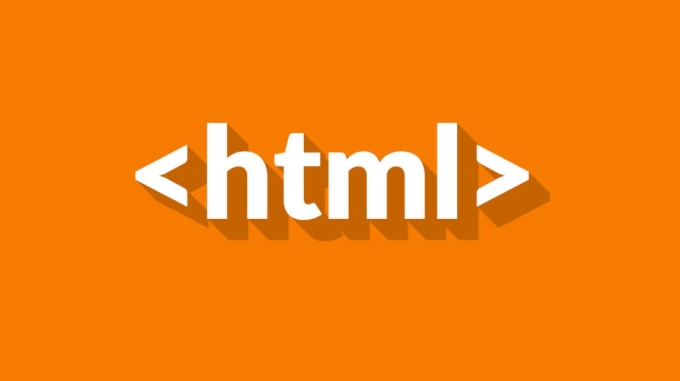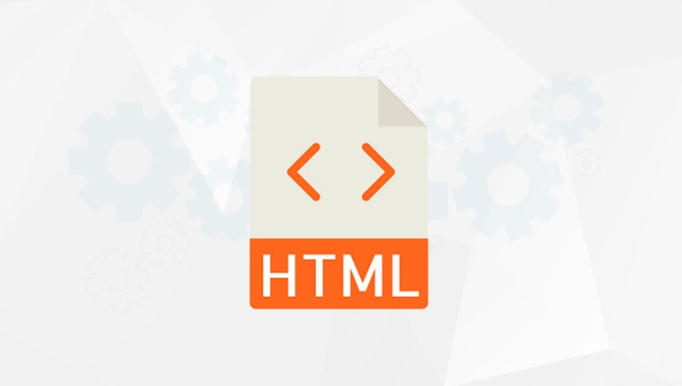HTML5 data attribute is a method of storing custom data in HTML elements, and has the advantages of not affecting page display and facilitating JavaScript operations. 1. In terms of definition, the data attribute is a custom attribute starting with data-, such as data-id or data-user-name. The browser does not handle it specially but allows JS to read and write; 2. Common uses include storing element-related information, passing parameters between components, reducing server requests, etc.; 3. The usage method is to add data-* attributes to HTML tags, such as

HTML5 data attributes is a good way to store custom data in HTML elements. It does not affect the page display and is convenient for JavaScript operations. It is simple, flexible, and has good compatibility.

What is a data attribute?
The data attribute is the attribute name that starts with data- , such as data-id="123" or data-user-name="John" . The browser does not do any special treatment for these properties, but you can easily access and modify them through JavaScript.
They are usually used to:

- Store additional information related to elements (such as ID, status, etc.)
- Passing data between front-end components
- Avoid frequent requests to the server to obtain known information
How to use it in HTML?
Just write data-* attribute in the tag, the format is very simple:
<div data-role="button" data-action="submit">Submit</div>
Here we have added two data attributes: data-role and data-action , and we can add multiple data as needed.

Need to note:
- The attribute name must start with
data- - Can contain letters, numbers, short horizontal lines, dots and colons
- Values can be any type of string or number, but they will be processed as strings.
How to get and set it with JavaScript?
Data properties can be manipulated through dataset objects:
const element = document.querySelector('[data-role="button"]'); // Get the value console.log(element.dataset.role); // Output: button console.log(element.dataset.action); // Output: submit // Set the value element.dataset.loading = "true"; // Now the element will become: data-loading="true"
A few tips:
- The key name of dataset is named camel, for example,
data-user-namewill becomedataset.userName - If the attribute name has multiple short horizontal lines, the following words will be converted to capitalization
- It does not support setting boolean values or numbers directly, remember to convert the type manually
Common scenarios in practical applications
Some common usages include:
State control of buttons
For example, a button in the loading state can usedata-loading="true"to mark whether it is currently loading. JavaScript decides whether to prevent repeated clicks based on this value.Dynamic menu or pop-up window transfer
For example, clicking on a user item to pop up the details, you can directly store the user ID indata-user-id, so as to avoid sending requests or maintaining global variables.Form verification assistance
Some fields may require specific rules, you can adddata-validate="email"to HTML, and then JS handles different rules uniformly.
Basically that's it. Although it seems quite basic, it is very practical in actual development, especially when combined with component development, it can greatly reduce the degree of code coupling.
The above is the detailed content of How to use HTML5 data attributes?. For more information, please follow other related articles on the PHP Chinese website!

Hot AI Tools

Undress AI Tool
Undress images for free

Undresser.AI Undress
AI-powered app for creating realistic nude photos

AI Clothes Remover
Online AI tool for removing clothes from photos.

Clothoff.io
AI clothes remover

Video Face Swap
Swap faces in any video effortlessly with our completely free AI face swap tool!

Hot Article

Hot Tools

Notepad++7.3.1
Easy-to-use and free code editor

SublimeText3 Chinese version
Chinese version, very easy to use

Zend Studio 13.0.1
Powerful PHP integrated development environment

Dreamweaver CS6
Visual web development tools

SublimeText3 Mac version
God-level code editing software (SublimeText3)

Hot Topics
 Audio and Video: HTML5 VS Youtube Embedding
Jun 19, 2025 am 12:51 AM
Audio and Video: HTML5 VS Youtube Embedding
Jun 19, 2025 am 12:51 AM
HTML5isbetterforcontrolandcustomization,whileYouTubeisbetterforeaseandperformance.1)HTML5allowsfortailoreduserexperiencesbutrequiresmanagingcodecsandcompatibility.2)YouTubeofferssimpleembeddingwithoptimizedperformancebutlimitscontroloverappearanceand
 What is the purpose of the input type='range'?
Jun 23, 2025 am 12:17 AM
What is the purpose of the input type='range'?
Jun 23, 2025 am 12:17 AM
inputtype="range" is used to create a slider control, allowing the user to select a value from a predefined range. 1. It is mainly suitable for scenes where values ??need to be selected intuitively, such as adjusting volume, brightness or scoring systems; 2. The basic structure includes min, max and step attributes, which set the minimum value, maximum value and step size respectively; 3. This value can be obtained and used in real time through JavaScript to improve the interactive experience; 4. It is recommended to display the current value and pay attention to accessibility and browser compatibility issues when using it.
 Adding drag and drop functionality using the HTML5 Drag and Drop API.
Jul 05, 2025 am 02:43 AM
Adding drag and drop functionality using the HTML5 Drag and Drop API.
Jul 05, 2025 am 02:43 AM
The way to add drag and drop functionality to a web page is to use HTML5's DragandDrop API, which is natively supported without additional libraries. The specific steps are as follows: 1. Set the element draggable="true" to enable drag; 2. Listen to dragstart, dragover, drop and dragend events; 3. Set data in dragstart, block default behavior in dragover, and handle logic in drop. In addition, element movement can be achieved through appendChild and file upload can be achieved through e.dataTransfer.files. Note: preventDefault must be called
 How can you animate an SVG with CSS?
Jun 30, 2025 am 02:06 AM
How can you animate an SVG with CSS?
Jun 30, 2025 am 02:06 AM
AnimatingSVGwithCSSispossibleusingkeyframesforbasicanimationsandtransitionsforinteractiveeffects.1.Use@keyframestodefineanimationstagesforpropertieslikescale,opacity,andcolor.2.ApplytheanimationtoSVGelementssuchas,,orviaCSSclasses.3.Forhoverorstate-b
 HTML audio and video: Examples
Jun 19, 2025 am 12:54 AM
HTML audio and video: Examples
Jun 19, 2025 am 12:54 AM
Audio and video elements in HTML can improve the dynamics and user experience of web pages. 1. Embed audio files using elements and realize automatic and loop playback of background music through autoplay and loop properties. 2. Use elements to embed video files, set width and height and controls properties, and provide multiple formats to ensure browser compatibility.
 What is WebRTC and what are its main use cases?
Jun 24, 2025 am 12:47 AM
What is WebRTC and what are its main use cases?
Jun 24, 2025 am 12:47 AM
WebRTC is a free, open source technology that supports real-time communication between browsers and devices. It realizes audio and video capture, encoding and point-to-point transmission through built-in API, without plug-ins. Its working principle includes: 1. The browser captures audio and video input; 2. The data is encoded and transmitted directly to another browser through a security protocol; 3. The signaling server assists in the initial connection but does not participate in media transmission; 4. The connection is established to achieve low-latency direct communication. The main application scenarios are: 1. Video conferencing (such as GoogleMeet, Jitsi); 2. Customer service voice/video chat; 3. Online games and collaborative applications; 4. IoT and real-time monitoring. Its advantages are cross-platform compatibility, no download required, default encryption and low latency, suitable for point-to-point communication
 How to create animations on a canvas using requestAnimationFrame()?
Jun 22, 2025 am 12:52 AM
How to create animations on a canvas using requestAnimationFrame()?
Jun 22, 2025 am 12:52 AM
The key to using requestAnimationFrame() to achieve smooth animation on HTMLCanvas is to understand its operating mechanism and cooperate with Canvas' drawing process. 1. requestAnimationFrame() is an API designed for animation by the browser. It can be synchronized with the screen refresh rate, avoid lag or tear, and is more efficient than setTimeout or setInterval; 2. The animation infrastructure includes preparing canvas elements, obtaining context, and defining the main loop function animate(), where the canvas is cleared and the next frame is requested for continuous redrawing; 3. To achieve dynamic effects, state variables, such as the coordinates of small balls, are updated in each frame, thereby forming
 How to check if a browser can play a specific video format?
Jun 28, 2025 am 02:06 AM
How to check if a browser can play a specific video format?
Jun 28, 2025 am 02:06 AM
To confirm whether the browser can play a specific video format, you can follow the following steps: 1. Check the browser's official documents or CanIuse website to understand the supported formats, such as Chrome supports MP4, WebM, etc., Safari mainly supports MP4; 2. Use HTML5 tag local test to load the video file to see if it can play normally; 3. Upload files with online tools such as VideoJSTechInsights or BrowserStackLive for cross-platform detection. When testing, you need to pay attention to the impact of the encoded version, and you cannot rely solely on the file suffix name to judge compatibility.






